
Whether you’re blogging for fun or for business, getting your posts ranking in the search engines is your ticket to traffic. But in order for that to happen, you first need to make sure your blog and your individual posts are properly optimized.
While SEO hasn’t fundamentally changed over the past few years, there are some strategies that have become more or less effective; and knowing which ones to focus on can save you tons of time and frustration.
This post will walk you through everything you need to know about SEO and your blog in 2016, including:
- Why blog optimization is important
- How to optimize your blog
- How to optimize your individual blog posts
- How to attract links that will boost your rankings
While there are other optimization strategies I haven’t included below, I have included the most effective and least time-consuming so you can start getting blog traffic ASAP!
Why optimize your blog?
Optimizing your blog means making sure the search engines can find and index all your valuable content. If they’re unable to access your site – or if they don’t know what your content is about– you won’t receive traffic from the search engines. It’s as simple as that.
When people search for keywords related to your blog posts, you obviously want your blog to show up on the first page of the search results; and ideally, in the top three spots. Here’s why: According to research done by Advanced Web Ranking, the first three spots in Google account for approximately 55 percent of all clicks – with the number one spot accounting for 31 percent of all clicks.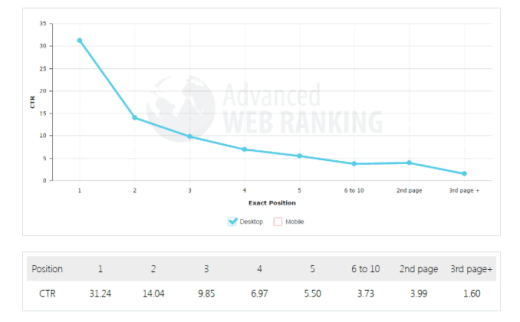
How to optimize your blog for rankings
Before you jump into writing blog content, it’s important to make sure you have a solid, search engine-friendly structure for your blog. This section will look at the most important elements of having a well-optimized blog.
1. Host your blog on your primary domain.
If you’re blogging as part of your business’s marketing strategy, it’s imperative that your blog is hosted on your company domain. For instance, if your website is www.yoursite.com, ideally your blog will be located at www.yoursite.com/blog/.
As your blog grows and begins attracting search traffic and links, you want all that important ‘link juice’ to spread to your company website as a whole. It’s also important that blog visitors know who you are, and why you’re blogging; and if your blog is hosted on a completely different domain, this may not be immediately apparent.
2. If possible, choose a .com domain.
If you’re just starting your blog, keep in mind that your TLD (top level domain) matters. According to Searchmetrics, 79 percent of top-ranking pages are hosted on .com domains. 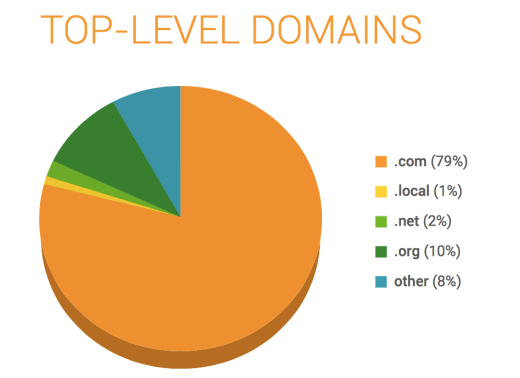
3. Make sure your blog is optimized for mobile.
If you’re using WordPress, this is a quick fix. There are many plugins that will automatically make your existing theme mobile-friendly. WPtouch Mobile Plugin will serve a mobile theme to anyone accessing your site on mobile, while still serving your existing theme to desktop users. If you’d prefer to convert your site to a mobile app, there’s a plugin for that too: Androapp lets you easily create and serve an Android app version of your site to mobile visitors.
Not sure if your blog is properly optimized for mobile? Run it through Google’s Mobile-Friendly Test.
4. Create sitemaps for the search engines and for users.
Sitemaps provide a way for search spiders and website visitors to find and navigate through your content. There are two types of sitemaps: XML sitemaps and HTML sitemaps.
HTML sitemaps, on the other hand, are meant for your human visitors. These give your blog visitors a way to find all your content…not just the posts and pages linked to in your menu or sidebar. A plugin like Hierarchical HTML Sitemaps can help with this.
5. Speed up your blog.
Site speed matters for rankings. There are many factors that can cause your site to lag, and this can hurt both your rankings and user experience. If you’re not sure how quickly your blog is loading, you can find out using Google’s PageSpeed Insights tool.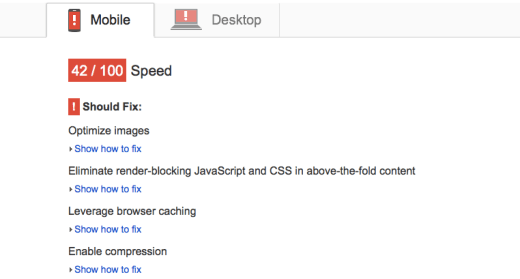
- Keeping your blog software up to date
- Leveraging browser caching on your site. If you’re using WordPress, a tool like W3 Total Cache can help with this.
- Reducing the size of your images if possible
- Getting rid of any unnecessary plugins that may be slowing down your site
Here is a complete list of ways to speed up your website from the folks at Kissmetrics.
How to optimize your blog posts
Once your blog is properly optimized, you can jump into the fun stuff – actually writing your blog posts. Following is a framework for writing blog posts that meet the needs of your audience while also attracting search traffic.
1. Find topics that matter to your audience.
You’ll often hear the mantra, “Write unique content”. The problem is, there’s not much to write about that’s truly unique or original anymore. Instead, focus on digging deeper into topics that your audience wants to know about.
Look through your blog comments, social media posts and website analytics to see which topics come up regularly. I also recommend doing some online sleuthing to see what people in your niche are talking about. Some of the best ways to do this are through engaging in social media monitoring and visiting niche forums.
2. Use keyword research to find specific keywords to target.
Once you have some topic ideas, you can drill down to find out which exact words or phrases people are using to find these topics. For instance, if you’ve determined that cats are a hot topic in your niche, keyword research can help you find related or more specific terms like ‘how to train a cat’ or ‘the best cat collars’.
Because short words or phrases tend to be harder to rank for, it’s best to focus on longer, more specific phrases. The added bonus is that by incorporating these “long-tail” phrases into your content, that content is more likely to meet the specific needs of your audience (and more likely to convert).
While there are many advanced tools you can use for keyword research, using Google’s Keyword Planner can give you a solid start at finding popular keywords that aren’t too hard to rank for.
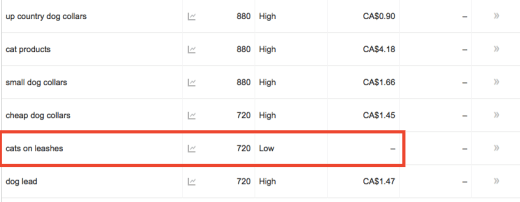
- It receives approximately 720 searches per month. Keep in mind that even if you were to rank #1 for this phrase, your search traffic would be lower than this; and if you rank for number two or three, the clickthroughs would be even lower. For this reason, choose phrases that receive at least 700 to 800 searches per month.
- There is a low level of AdWords competition. While this doesn’t tell us exactly how hard it will be to rank organically, it does suggest that the competition won’t be overly fierce.
- There is no suggested bid for this phrase. This indicates that this keyword has low commercial value… meaning most people who search for this phrase likely aren’t looking to make a purchase.
Once you’ve found a phrase you’d like to use and think you can rank for, you can jump into writing your post!
Looking for more help with your keyword research? Here’s a primer on doing keyword research like the pros.
3. Write longer content.
Bloggers used to be able to get away with writing short (<400 word) blog posts that targeted a particular keyword. So long as they did a sufficient job of incorporating that keyword, they stood a good chance of ranking.
This is no longer the case. The vast majority of successful online content is now longer and more in-depth. Instead of targeting one or two keywords, this content comprehensively covers a specific topic or theme.
According to Moz, 85 percent of content published online is less than 1,000 words; but content that’s longer than 1,000 words tends to attract more links and social shares.
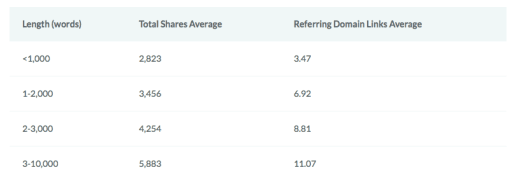
4. Make sure your content is optimized from a technical standpoint.
Search engines have gotten really good at determining the topic of a page…meaning sometimes you can rank for a particular keyword even if you never use that word on your page! That said, using your keywords in prime locations on your page is still important.
The most important places to use your keywords are in your:
- Title tag
- Header tags (H1, H2, etc.)
- URL (e.g., www.yoursite.com/your-keywords-here). If your URLs contain a bunch of numbers and characters, it’s important to switch to a static URL structure. Here is a good overview of dynamic vs. static URLs.
- Image captions
- Alt image tag (where appropriate)
- Several times throughout your content
5. Focus on promoting your content, not just creating it.
Many bloggers get so hung up on writing content that they fail to properly promote and distribute it. Unfortunately, this is why so many great blog posts end up getting zero traction.
Creating your content is just the beginning. Have a consistent routine in place for making sure that content gets in front of your audience. This can include free strategies like promotion on social media, or sending out a link to your email subscribers. If you don’t already have an established audience, you may want to consider paid options like social ads or Google Adwords. I also like using Haro to promote amazing content.
Link building strategies for your blog
Link building in 2016 should be focused on “pulling” readers in: writing excellent blog posts that naturally accumulate links.
Links remain the primary way that Google understands the importance of your blog. Generally speaking, the more high-quality sites that link to your blog, the higher your rankings will be (of course, it isn’t quite this simple… but you get the point!).
Link building of the past was often based on a “push” model: for example, asking for links from other bloggers, submitting your blog to directories and publishing link-heavy press releases.
An effective link building strategy today, on the other hand, is far more about “pull”: creating excellent content that naturally accumulates inbound links. It’s more about earning links, and less about asking for them.
This doesn’t mean, however, that you can’t be intentional in how you go about earning these links. Following are 5 strategies you can use to naturally acquire high-quality links to your blog.
1. Focus on being an industry resource for bloggers and journalists.
Certain types of blog posts are far more likely to attract links from other bloggers and journalists. When deciding what to write about, consider what types of content they typically link to in their posts and stories.
Some post types that typically work well are tutorials, research-backed content and resource lists (e.g., “Top 10 Quietest Dishwashers”). You can also think about questions or problems that come up frequently in your industry, and then provide your own in-depth analysis or discussion.
Evergreen posts (posts that remain relevant over time) are more likely to attract links over the long-haul, however covering breaking news may also help you earn a quick dose of links.
2. Link internally to your own posts.
Internal linking remains an important part of blog optimization in 2016. According to Searchmetrics’ 2015 Ranking Factors report, a good internal link structure is important both for rankings and for user experience: “What counts is not the total number of internal links, but rather the optimization of the internal structure and page information so that the user (and also the search engine) is optimally guided through the provider’s content and to ensure that the user stays on the page and is satisfied.”
While SEOs used to advise bloggers to use keyword-rich anchor text in their internal links (i.e., using their desired keywords in the link text), current best practice is to use the most natural and obvious anchor text. Instead of focusing on which keywords you want to rank for, focus on choosing text that will make the most sense to your readers.
3. Guest blog on well-known sites.
Yes, guest blogging is still relevant in 2016. Reach out to well-known publications and blogs in your industry to see if you can contribute a guest post or even become a regular contributor.
The beauty of guest blogging in 2016 is that you don’t need to stress out over which anchor text to use, and how and where to include links back to your site. Even if the link back to your site is nofollowed (i.e., it doesn’t pass ‘link juice’ to your blog), you still get referral traffic and the benefit of an implied link. Always remember that authenticity is key.
4. Reach out to influencers in your niche.
Write blog posts that mention or quote a well-known figure in your industry; you can even reach out and ask for a quote or interview. Once your post is live, let them know about it, either by email or by tagging or mentioning them on social media. Best case scenario, they share the post with their social media followers and link to it on their site or blog.
5. More content = more potential for links.
Obvious, right? The more high-quality posts you publish, the more links you’ll potentially accumulate. The same goes for sharing those blog posts. Don’t be afraid to share them with your audience again and again over time. Each time your content gets in front of your readers, you increase exposure, social media shares and potentially links.
For more link building strategies for 2016, see my posts 6 Link Building Techniques You May Not Have Thought of and 7 Killer Link Building Strategies For Small Businesses.
Conclusion
The strategies above should give you a great chance of getting your blog ranking in 2016. Keep in mind that while it’s important to cover your bases from a technical standpoint, today’s SEO is more about creating excellent, comprehensive content that attracts both search engines and readers.
Read next: 7 tips to turn your blog into a business
Get the TNW newsletter
Get the most important tech news in your inbox each week.





